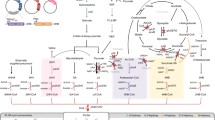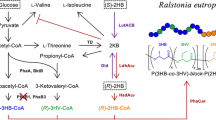Abstract
Novel lactate (LA)-based terpolymers, P[LA-co-3-hydroxybutyrate(3HB)-co-3-hydroxyvalerate(3HV)]s (PLBVs), were produced in LA-overproducing mutant, Escherichia coli JW0885, which was found to be a superior host for the efficient production of LA-based polyesters. Recombinant E. coli JW0885 harboring the genes encoding LA-polymerizing enzyme (Ser325Thr/Gln481Lys mutant of polyhydroxyalkanoate synthase from Pseudomonas sp. 61-3) and three monomer supplying enzymes [propionyl-CoA transferase, β-ketothiolase, and nicotinamide adenine dinucleotide phosphate (reduced form) (NADPH)-dependent acetoacetyl-CoA reductase] was aerobically grown on glucose with feeding of propionate as a precursor of 3-hydroxyvaleryl-CoA (3HV-CoA). Gas chromatography and nuclear magnetic resonance (NMR) analyses revealed that polymers accumulated in the cells were composed of LA, 3HB, and 3HV units, thus being identified as terpolymers, PLBVs. In addition, 1H-NMR analysis suggested the existence of LA-3HV sequence in the terpolymer. When 100 mg/l of sodium propionate was added into the medium, 3HV fraction in the terpolymer linearly reached up to 7.2 mol%, while LA fraction was inversely decreased. This phenomenon could be due to the change in metabolic fluxes of lactyl-CoA (LA-CoA) and 3HV-CoA depending on the concentration of propionate fed into the medium.



Similar content being viewed by others
References
Aldor IS, Keasling JD (2003) Process design for microbial plastic factories: metabolic engineering of polyhydroxyalkanoates. Curr Opin Biotechnol 14:475–483
Anderson AJ, Dawes EA (1990) Occurrence, metabolism, metabolic role, and industrial uses of bacterial polyhydroxyalkanoates. Microbiol Rev 54:450–472
Baba T, Ara T, Hasegawa M, Takai Y, Okumura Y, Baba M, Datsenko KA, Tomita M, Wanner BL, Mori H (2006) Construction of Escherichia coli K-12 in-frame, single-gene knockout mutants: the Keio collection. Mol Syst Biol 2:1–11
Blank L, Green J, Guest JR (2002) AcnC of Escherichia coli is a 2-methylcitrate dehydratase (PrpD) that can use citrate and isocitrate as substrates. Microbiology 148:133–146
Doi Y, Kunioka M, Nakamura Y, Soga K (1986) Nuclear magnetic resonance studies on poly(beta-hydroxybutyrate) and a copolyester of beta-hydroxybutyrate and beta-hydroxyvalerate isolated from Alcaligenes eutrophus H16. Macromolecules 19:2860–2864
Elsden SR, Gilchrist FM, Lewis D, Volcani BE (1956) Properties of a fatty acid forming organism isolated from the rumen of sheep. J Bacteriol 72:681–689
Holmes PA (1985) Applications of PHB—a microbially produced biodegradable thermoplastic. Phys Technol 16:32–36
Jia Z, Zhang K, Tan J, Han C, Dong L, Yang Y (2009) Crystallization behavior and mechanical properties of crosslinked plasticized poly(L-lactic acid). J Appl Polym Sci 111:1530–1539
Kato M, Bao HJ, Kang CK, Fukui T, Doi Y (1996) Production of a novel copolyester of 3-hydroxybutyric acid and medium-chain-length 3-hydroxyalkanoic acids by Pseudomonas sp. 61–3 from sugars. Appl Microbiol Biotechnol 45:363–370
Kulinski Z, Piorkowska E, Gadzinowska K, Stasiak M (2006) Plasticization of poly(L-lactide) with poly(propylene glycol). Biomacromolecules 7:2128–2135
Matsumoto K, Murata T, Nagao R, Nomura CT, Arai S, Arai Y, Takase K, Nakashita H, Taguchi S, Shimada H (2009) Production of short-chain-length/medium-chain-length polyhydroxyalkanoate (PHA) copolymer in the plastid of Arabidopsis thaliana using an engineered 3-ketoacyl-acyl carrier protein synthase III. Biomacromolecules 10:686–690
Matsusaki H, Abe H, Doi Y (2000) Biosynthesis and properties of poly(3-hydroxybutyrate-co-3-hydroxyalkanoates) by recombinant strains of Pseudomonas sp. 61–3. Biomacromolecules 1:17–22
Matsusaki H, Manji S, Taguchi K, Kato M, Fukui T, Doi Y (1998) Cloning and molecular analysis of the poly(3-hydroxybutyrate) and poly(3-hydroxybutyrate-co-3-hydroxyalkanoate) biosynthesis genes in Pseudomonas sp. strain 61–3. J Bacteriol 180:6459–6467
Schubert P, Steinbüchel A, Schlegel HG (1988) Cloning of the Alcaligenes eutrophus genes for synthesis of poly-beta-hydroxybutyric acid (PHB) and synthesis of PHB in Escherichia coli. J Bacteriol 170:5837–5847
Schweiger G, Buckel W (1984) On the dehydration of (R)-lactate in the fermentation of alanine to propionate by Clostridium propionicum. FEBS letters 171:79–84
Shirahama H, Tanaka A, Yasuda H (2002) Highly biodegradable copolymers composed of chiral depsipeptide and L-lactide units with favorable physical properties. J Polym Sci A Polym Chem 40:302–316
Slater S, Gallaher T, Dennis D (1992) Production of poly-(3-hydroxybutyrate-co-3-hydroxyvalerate) in a recombinant Escherichia coli strain. Appl Environ Microbiol 58:1089–1094
Sudesh K, Abe H, Doi Y (2000) Synthesis, structure and properties of polyhydroxyalkanoates: biological polyester. Prog Polym Sci 25:1503–1555
Taguchi S, Yamada M, Matsumoto K, Tajima K, Satoh Y, Munekata M, Ohno K, Kohda K, Shimamura T, Kambe H, Obata S (2008) A microbial factory for lactate-based polyesters using a lactate-polymerizing enzyme. Proc Natl Acad Sci U S A 105:17323–17327
Takase K, Matsumoto K, Taguchi S, Doi Y (2004) Alteration of substrate chain-length specificity of type II synthase for polyhydroxyalkanoate biosynthesis by in vitro evolution: in vivo and in vitro enzyme assays. Biomacromolecules 5:480–485
Tsuji H (2002) Polylactide. In: Doi Y, Steinbüchel A (eds) Biopolymers. Wiley-VCH, Weinheim, pp 129–177
Yamada M, Matsumoto K, Nakai T, Taguchi S (2009) Microbial production of lactate-enriched poly[(R)-lactate-co-(R)-3-hydroxybutyrate] with novel thermal properties. Biomacromolecules 10:677–681
Yim KS, Lee SY, Chang HN (1996) Synthesis of poly-(3-hydroxybutyrate-co-3-hydroxyvalerate) by recombinant Escherichia coli. Biotechnol Bioeng 49:495–503
Zhu J, Shimizu K (2005) Effect of a single-gene knockout on the metabolic regulation in Escherichia coli for D-lactate production under microaerobic condition. Metab Eng 7:104–115
Acknowledgements
We thank NBRP (NIG, Japan): E. coli for providing E. coli JW0885. This work was supported by funding from the following sources: Grant-in-Aid for Scientific Research of Japan (no. 70216828) from the Ministry of Education, Culture, Sports, Science, and Technology of Japan (to S. Taguchi) and the Global Center of Excellence Program (project no. B01: Catalysis as the Basis for Innovation in Materials Science) from the Ministry of Education, Culture, Sports, Science, and Technology, Japan.
Author information
Authors and Affiliations
Corresponding author
Rights and permissions
About this article
Cite this article
Shozui, F., Matsumoto, K., Nakai, T. et al. Biosynthesis of novel terpolymers poly(lactate-co-3-hydroxybutyrate-co-3-hydroxyvalerate)s in lactate-overproducing mutant Escherichia coli JW0885 by feeding propionate as a precursor of 3-hydroxyvalerate. Appl Microbiol Biotechnol 85, 949–954 (2010). https://doi.org/10.1007/s00253-009-2100-y
Received:
Revised:
Accepted:
Published:
Issue Date:
DOI: https://doi.org/10.1007/s00253-009-2100-y




